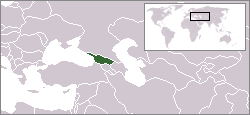Live grenade thrown at George Bush in Georgia
Wednesday, May 18, 2005

(Image missing from Commons: image; log)

On May 10 while visiting Georgia's capital Tbilisi a live hand grenade landed within 100 feet of United States President George W. Bush.
The grenade was wrapped in a dark plaid cloth handkerchief. According to Brian Paarmann, the FBI's legal attache at the U.S. Embassy in Tbilisi, it was "tossed in the general direction of the main stage" about 1:30 p.m., right after Bush began speaking, and landed less than 100 feet from the podium. The grenade reportedly bounced off a child's cap and then was removed by a Georgian security officer.
The White House initially stated that the president was in no real danger, however the event has lead to a review of security measures at presidential events.
An FBI official at the U.S. embassy in Georgia confirms that an explosive device was thrown, but due to a malfunction it failed to detonate. "This hand grenade appears to be a live device that simply failed to function due to a light strike on the blasting cap induced by a slow deployment of the spoon activation device," the FBI stated.
The FBI is still investigating the incident. According to their report the device failed to explode because of a malfunction. "The activation device deployed too slowly to hit the blasting cap hard enough," agent Bryan Paarmann said. A 20,000 laris (US$10,978) reward is offered for information leading to the arrest of the person responsible.
The grenade was a knock-off of a Soviet-designed RGD-5, which has a lethal range of about 100 feet. "We consider this act to be a threat against the health and welfare of both the president of the United States and the president of Georgia as well as the multitude of Georgian people that had turned out at this event," Paarmann said. It had initially been believed to be a non-explosive model used for military training.
RGD-5 Grenade
editThe RGD-5 is an oval fragmentation grenade made for the former Soviet Army that can be thrown a maximum of about 130 feet (40 meters). It weighs 310 grams and contains 110 grams of TNT explosive. It is most dangerous at shorter ranges; its effective fragment radius is 50-65 feet (15-20 meters), with a maximum fragment range of 100 feet (30 meters).
The RDG-5 is available in two versions, one for defensive use with steel fragments, and an offensive version with aluminium fragments that has a shorter blast radius. It is unclear which version was found.
A classic hand grenade has a handle and a removable safety pin that prevents the handle from coming off. After the pin is removed and the handle subsequently released, the grenade will detonate in approximately three to five seconds, depending on grenade type.
When the grenade is thrown, a spring throws off the safety lever and rotates the striker into the primer. The primer contains material like the head of a match. When struck by the striker, it ignites and sets fire to the fuse, or powder train. The fuse burns at a controlled rate, providing a time delay (usually 4–5 seconds). When the flame of the fuse reaches the detonator or igniter, it causes action on the filler.
A detonator is similar to a small blasting cap, and is very sensitive to heat. When the fuse burns into it, it causes the grenade to explode.
Sources
edit- Jennifer Loven. "FBI Says Grenade Tossed Near Bush Was Live" — Associated Press, May 18, 2005
- "Grenade thrown at Bush on Georgia trip, FBI says" — Telegraph, May 18, 2005
- "Grenade near Bush 'was live'" — CNN, May 18, 2005
- C. J. Chivers. "Georgia and U.S. Study Origin of a Grenade Seen Near Bush" — NY Times, May 12, 2005